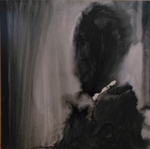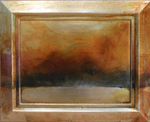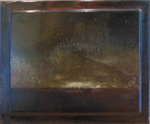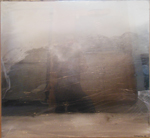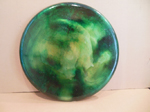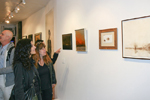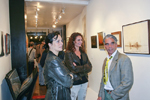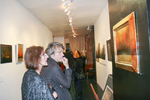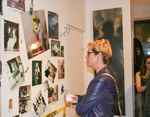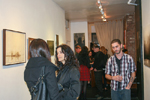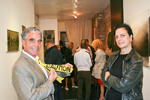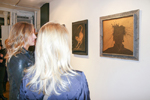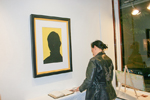Dorian Grey Gallery | Tel: 516 244 4126
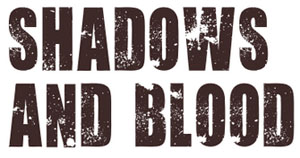
Curated by Robert Murphy
Exhibition Dates: October 9th - November 9th, 2014
Opening Reception October 9th, 6-9pm
Press
Papermag
Richard Hambleton, By Clayton Patterson
Richard Hambleton is an enigma, hard to pin down. His work is seen, but, often he is not. An early 1980's portrait of Richard is included in a book of artists' portraits by Timothy Greenfield Sanders. He has the movie star good looks of James Dean.
In the early 1980's when walking the streets, or riding the subway, an individual had to have their antennae up because there was always the chance that some kind of danger could be lurking just seconds away. Artists like Keith Haring helped relieve the feeling of fear of the unknown by placing fun, playful, graphic images in public spaces. Richard added to the tension with his street performance piece: Image Mass Murder. Richard would have a person lay on the ground, in a fallen position, then paint a white chalk outline around the figure, splash a little red paint around, leaving the impression of a police crime scene. Of course, many viewers believed they were walking by a place someone had recently been murdered.
In his next, and most memorable series of street works, Richard created the Shadow paintings, which were especially effective at night. This iconic series terrorized and caused fear in the hearts of many unsuspecting passers-by. Quickly painted, these ominous, life-sized, black figures, were placed in strategic spots on dimly lit streets. The darkness helped give the impression of a real person hiding in the shadow. The tense, alert, nighttime walker would pick up the shadow figure in the corner of their eye. Glancing sideways they would see this shadow figure. If only for a moment these shadow images startled the wary person.
Another of Richards menacing Street Art pieces were his life-sized photos of himself, stiff in posture, dressed in a rumpled suit, vest, white shirt, black tie, in a Napoleonic stance with right hand in jacket, left hand tight in his suit jacket pocket, schizoid looking staring eyes. These paper printed images were wheat pasted on Downtown building walls.
Richard was associated with the early 80's East Village art scene. He is one of the artists in the group portrait, The Irascibles, by Timothy Greenfield Sanders. Hambleton's work was exhibited in a number of pivotal underground galleries such as ABC No Rio, Club 57, Public Image Gallery, Squat Theater, and Fashion Moda. His work was included in two seminal exhibitions; 1980's Times Square Show. The influential arts group Colab was thus born and led to ABC No Rio's 1980 exhibition, Real Estate Show.
Richard is one of the few artists who broke away from the East Village art scene and began showing in the then trend setting, fashionable, SoHo galleries, starting with an exhibition of his Shadow work in the Alexander Milliken Gallery. The great debate that surround this show was whether the Shadow paintings stood up as art painted on canvas and shown in a gallery, or not. The critics who believe the work died when it left the street were proven wrong.
Soon, Hambleton was exhibiting internationally: Berlin, Antwerp, Rome, Milan, Vancouver, Venice, and so on. In the early 80's many expected Richard to be the stand out artist of the period.
Although Richard's body has been ravaged by ailments and addiction, he has persevered and continued to create. Fighting the insurmountable odds of life-threatening illnesses, homelessness, arrests and trashed works, Richard has continued to make inspired art. Life's struggles destroyed Van Gough's spirit. Not Richard's.
When I look at Richard's beautiful paintings I think of Albert Pinkham Ryder's visionary seascape and mysterious paintings. Dark storm warnings, more sky with a low horizon, or the serenity and beauty of an illuminated cloud filled sky. Ryder's use of non-traditional materials: heavy varnish, a tar like substance, wax, grease. Richard uses blood, heavy varnishes, urethane, house paint, gold and silver leaf, tin foil. It seems that both artists used whatever material was available at the time of creative need, unorthodox or whatever.
Another artist, I relate to Richard, is the English Romantic artist William Turner. For example the light and colors in paintings like The Morning After The Deluge. It is also speculated that Turner, in order to fully comprehend the power of the storm, desired to live in the eye of the storm. During one storm he tied himself to the mast of a ship. Must live it to paint it. Richard has lived through the storms that life threw in his path. I have witnessed Richard painting with black house paint and house painter brush, on a piece of found Styrofoam, on the street during a snow storm. For me, one difference between Ryder, Turner, and Richard is that the first two artists' heroic struggle is between man and nature. Richard's struggle is with himself and his own nature. Some speculate that Richard's landscapes are inspired by images which are formed within the liquid in a syringe. Once the syringe hits a vein, rather than just push the drug into the vein, he pulls back on the syringe and draws the blood out of his vein. As the blood mixes with the heroin and water, the blood slowly rolls and forms cloud-like landscapes and shapes.
In the end it is not the life or lifestyle artists have lived, it is the art that counts. In the end, I believe Richard's art will pass the test of time and he will have left a mark that people in the future will appreciate.
Press
MNYC Blog
Gallery Contact:
Christopher Pusey 516 244 4126






